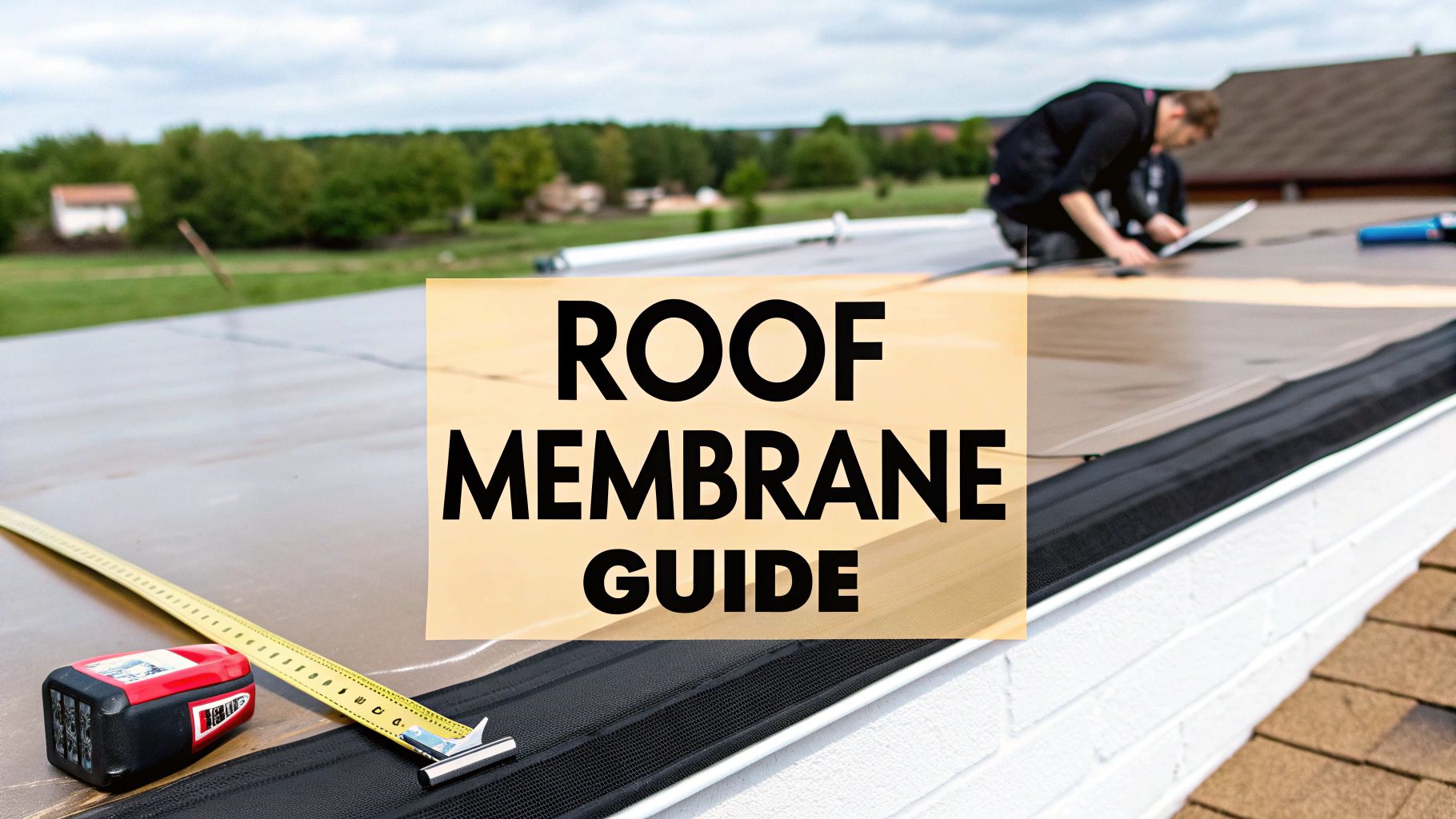When you hear "roof membrane," think of it as a single, continuous, watertight layer—a seamless raincoat for your home. It's the go-to solution for flat or low-slope roofs, where traditional shingles would inevitably leak. Understanding your options is the first step to making a smart, long-term investment in protecting your home from South Florida's weather.
Your Home's Ultimate Raincoat: A Practical Breakdown
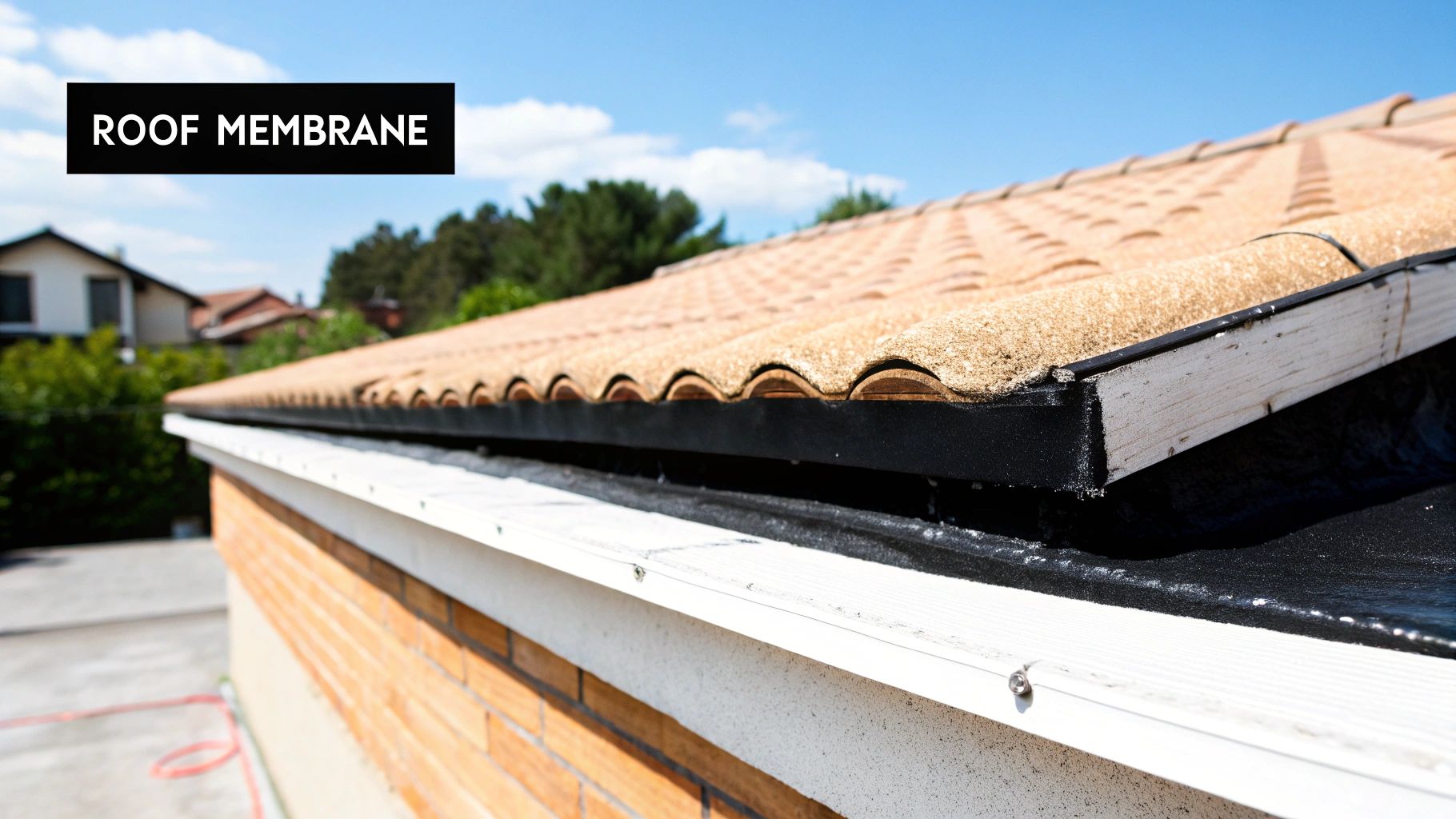
It’s easy to picture how water sheds off a steep, shingled roof. Gravity does all the work. But on a flat or nearly flat surface, water pools. Every seam between shingles becomes a potential entry point for a disastrous leak. This is the exact problem a modern roof membrane was engineered to solve.
Instead of thousands of overlapping pieces with countless gaps, a roof membrane creates one solid, unified surface. To achieve this, professionals roll out a high-tech sheet of material—usually an advanced rubber or thermoplastic—and then fuse the seams with specialized heat-welding tools or industrial-strength adhesives. The result is a monolithic barrier with no entry points for water.
Why This Matters for Your Home and Wallet
Knowing what is a roof membrane is about understanding its direct benefits. It’s a complete roofing system designed to protect your property and lower your bills. For any homeowner in South Florida, these systems are essential for three actionable reasons:
- Prevent Catastrophic Water Damage: Actionable step one is stopping leaks. A professionally installed membrane is your best defense against the structural rot, dangerous mold growth, and ruined interiors that come from persistent water intrusion.
- Beat the Florida Sun: Actionable step two is cutting cooling costs. Many modern membranes are brilliant white. They reflect the sun's harsh UV rays, creating a "cool roof" that dramatically reduces heat buildup in your home.
- Boost Energy Efficiency: By keeping your home and attic cooler, a reflective roof membrane eases the constant strain on your air conditioning. You will see a tangible difference in your monthly energy bills.
A roof membrane isn't just a layer; it's a protective shield. Your actionable takeaway is this: It actively manages water, heat, and UV exposure in a way that old-school roofing materials can't on low-slope designs, directly ensuring the long-term integrity of your property.
At the end of the day, a roof membrane is a tough, modern, and efficient solution built to safeguard your most important investment.
How to Choose the Right Roof Membrane Material
Walking into a conversation about roof membranes can feel like you're trying to order from a secret menu. TPO, EPDM, PVC—it's a confusing jumble of letters. The key is to get past the acronyms and understand how to match a material's strengths to your specific needs.
Your goal isn't just to pick a material, but to match its core strengths to your home, your budget, and your long-term goals. Let's break down the most popular options so you can make a confident, informed decision.
TPO: The Energy Saver
Thermoplastic Polyolefin (TPO) has become a top choice for modern flat roofs. Choose TPO if your primary goal is to lower your summer energy bills. It’s almost always a brilliant white, a color specifically chosen to reflect the sun's heat. This "cool roof" effect means your AC doesn't have to work as hard, leading to real savings.
A key practical advantage is its heat-welded seams. This process melts the material together, creating a single, solid sheet across your roof. That molecular bond makes the seams incredibly strong and leak-resistant—a non-negotiable feature in our rainy climate.
EPDM: The Durable Workhorse
If TPO is the new kid on the block, Ethylene Propylene Diene Monomer (EPDM) is the seasoned veteran. This is a synthetic rubber membrane known for one thing: incredible durability. Choose EPDM if your top priority is maximum longevity and proven performance. It often lasts 25 to 30 years or even longer with proper maintenance.
Its classic black color is excellent at resisting UV degradation. While it doesn't reflect heat like TPO, its sheer resilience makes it a top choice for homeowners who want a roof they can count on for decades. This rock-solid reputation is why EPDM is such a dominant force in the industry.
In fact, the global roofing market is booming, expected to grow from US$ 16.1 billion in 2022 to US$ 26.8 billion by 2031. EPDM leads the pack, holding about a 24% share of the market thanks to its long-standing trust and durability. You can dig deeper into the data on the roofing membrane market to see just how significant its role is.
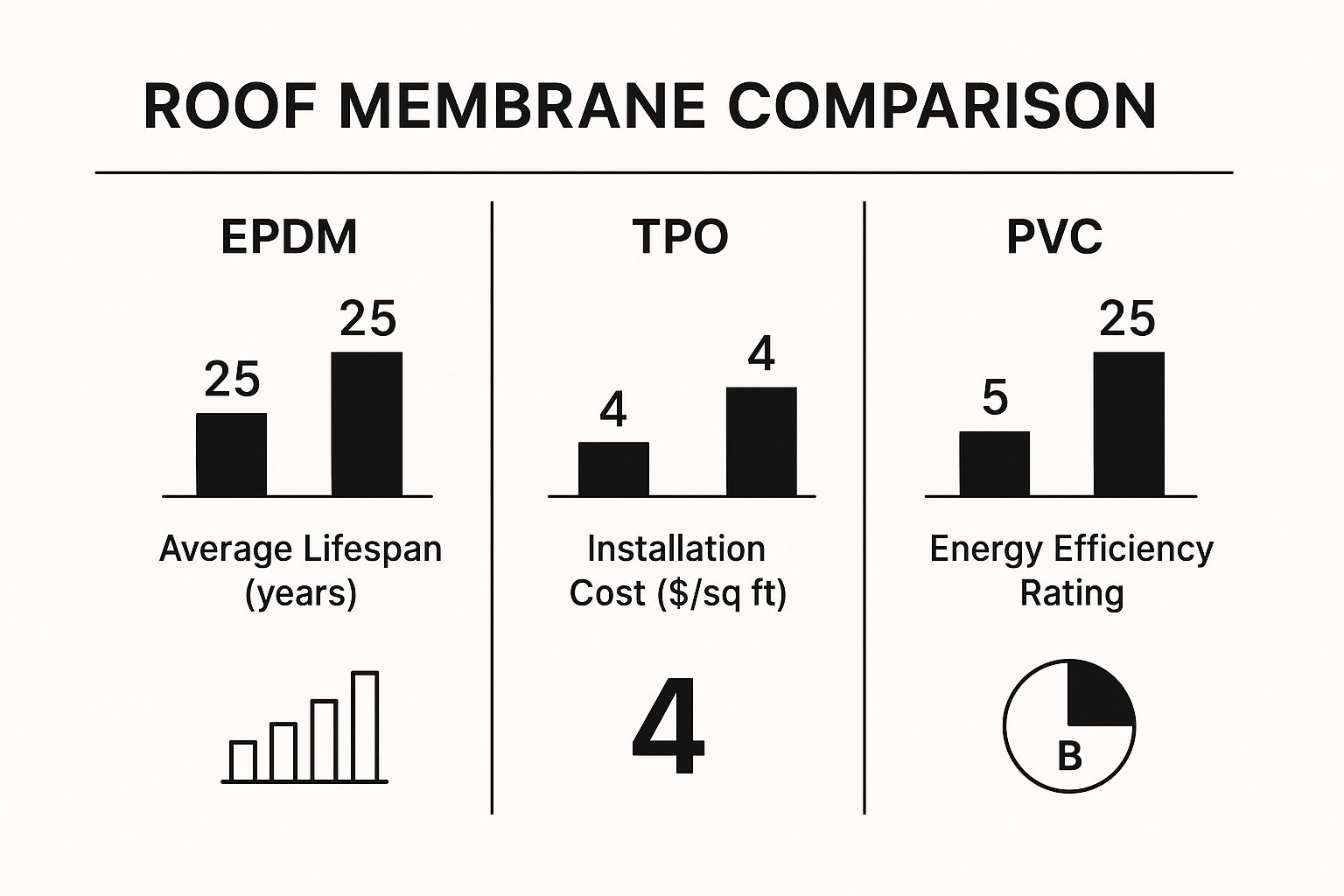
This chart helps put things in perspective, showing the trade-offs between what you pay upfront, how long the roof will last, and its energy-saving potential. It makes it much easier to see which material truly fits your priorities.
PVC: The Resilient Protector
Think of Polyvinyl Chloride (PVC) as the premium, heavy-duty option. Choose PVC if your roof is exposed to unique challenges like chemicals, grease, or frequent foot traffic. It’s known for its outstanding strength and resistance. If your roof is near a restaurant's vent or you have maintenance crews walking on it often, PVC is the smart, durable choice.
Just like TPO, PVC seams are heat-welded to form a completely watertight and incredibly durable roofing system. While it comes with a higher price tag, for those specific, demanding situations where other materials might fail, its superior resilience makes it a sound long-term investment.
Modified Bitumen: The Tough Traditionalist
Modified Bitumen (Mod-Bit) is the modern version of old-school asphalt roofing, but with key upgrades. Choose Mod-Bit if your roof needs to withstand heavy foot traffic or has a lot of equipment on it. It's built in multiple layers, which gives it fantastic tear resistance.
While single-ply membranes like TPO and PVC get more attention, Mod-Bit is still a go-to for its sheer, tough-as-nails reliability. It's often installed using torches to adhere the layers, creating a thick, robust, and proven waterproof shield for your home.
Comparing Popular Roof Membrane Materials
To make your decision easier, here is a direct comparison. Use this table to align your primary need with the best material choice.
| Membrane Type | Key Benefit | Average Lifespan | Best For | Considerations |
|---|---|---|---|---|
| TPO | Energy Efficiency | 15-22 Years | Homes in hot climates; homeowners focused on lowering energy bills. | Newer technology, quality can vary between brands. |
| EPDM | Durability & Longevity | 25-30+ Years | Homeowners prioritizing a long, proven lifespan over reflectivity. | Black color absorbs heat; seams require adhesive. |
| PVC | Chemical & Puncture Resistance | 20-30+ Years | Roofs with chemical exposure, high foot traffic, or grease vents. | Higher upfront cost compared to TPO and EPDM. |
| Modified Bitumen | Extreme Toughness | 10-20 Years | Roofs with heavy foot traffic or equipment. | Shorter lifespan; torch-down application requires skill. |
Ultimately, choosing the right material isn't about finding the single "best" one, but the best one for your home, your climate, and your budget. This comparison should give you a solid foundation for making an informed choice.
The Hidden Benefits Beyond Waterproofing
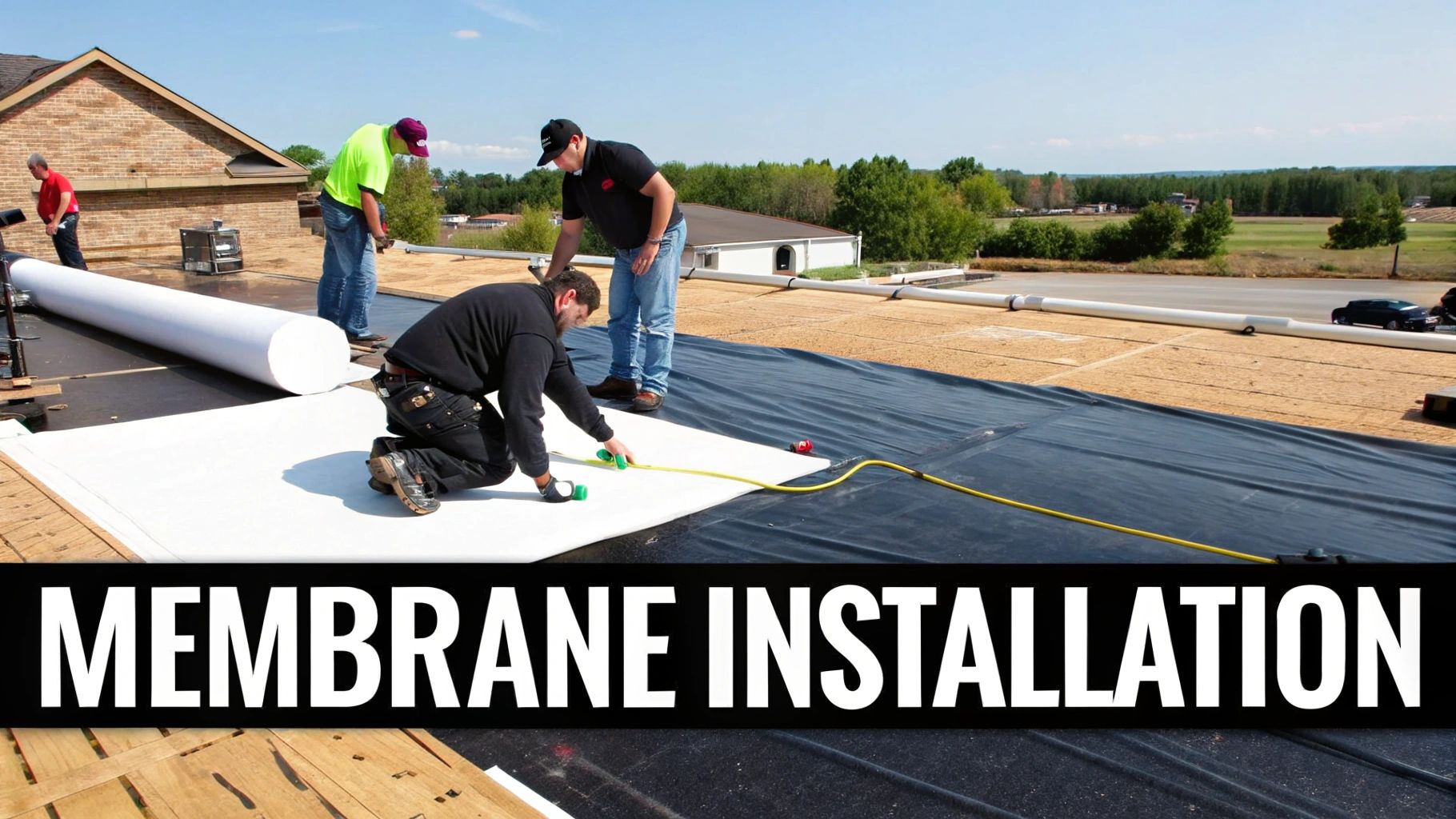
Most people stop at "waterproofing," but a modern membrane does more. It's a high-performance system that actively improves your home and lowers your monthly bills. Let's look at the actionable benefits you can expect.
These systems offer powerful perks that go beyond keeping rain out, from slashing your cooling costs to making your home a healthier place for your family.
Turning Your Roof Into an Energy-Saving Machine
In South Florida, the sun is relentless. Your roof absorbs heat, forcing your air conditioner to run nonstop. A "cool roof" membrane flips that script.
Here's how to take action: Choose a light-colored TPO or PVC membrane to act as a mirror for the sun. They reflect a huge chunk of solar heat back into the atmosphere instead of letting it seep into your home. This simple choice keeps your attic and living spaces cooler, giving your AC unit a break. The result is lower energy bills, especially during scorching summer months.
The market for these systems is booming for a reason, expected to climb from USD 12.5 billion to USD 18.7 billion by 2033. Since your roof can be responsible for 30% of your home's heat gain, installing an effective membrane is one of the most practical steps you can take to fight back.
Enhancing Your Home's Health and Value
A roof membrane also creates a healthier home. By forming a seamless barrier, it stops the slow, creeping moisture that often goes unnoticed with other roof types. This is a game-changer for preventing mold and mildew growth, which are notorious for triggering allergies and respiratory issues.
Beyond just keeping rain out, a properly installed roof membrane system also plays a vital role in preventing internal moisture issues, such as those identified during a detailed condensation risk assessment.
This directly leads to better air quality for your family. Ensuring a healthy living space is one of the most important things we can do to protect the people we care about, a core idea when we think about family safety and your home's roof.
These benefits add up to a real financial return. When you sell, a durable, low-maintenance, and energy-efficient roof is a huge plus for buyers. You're not just getting a roof; you're making a smart investment in long-term savings and a healthier home.
How Professionals Install a Roof Membrane
A roof membrane's performance hinges on the quality of the installation. Even the best material will fail if not installed correctly. Knowing the process helps you ask the right questions and ensure your roofer is building a roof to last.
The process starts with preparing the "substrate"—the roof deck itself. This means getting it perfectly clean, dry, and structurally sound. Any old, damaged material is torn off, and the surface is smoothed so nothing can puncture the new membrane.
The Core Installation Methods
Once the roof is prepped, your roofer will use one of three main methods. The right choice depends on your building’s structure, South Florida’s demanding building codes, and your budget.
- Mechanically Attached: Large plates and special fasteners are driven through the membrane into the roof deck. This is a common and cost-effective method suitable for many applications.
- Fully Adhered: A powerful bonding adhesive is spread across the substrate, and the membrane is rolled into it. This creates a solid bond across the entire roof, offering the best defense against wind uplift—a must-have in hurricane-prone areas.
- Ballasted: The membrane is laid loosely over the roof deck and held down by weight, typically a thick layer of smooth river stones or heavy concrete pavers. While less common for homes, it is a time-tested and rugged method.
No matter which method is used, the most critical step is getting the seam integrity perfect. For TPO and PVC, professionals use a hot-air welder to literally melt the seams together. This creates a molecular bond that's actually stronger than the membrane material itself, turning multiple sheets into one seamless, waterproof surface.
What to Look for in a Quality Job
The small details make all the difference. Meticulous flashing—the waterproofing around every pipe, vent, drain, and edge—is where skill truly shows. This is where most leaks start. A good roofer will spend significant time ensuring these complex areas are perfectly sealed.
If you want to dig deeper into the hands-on side of things, you can find some great general installation and maintenance resources online. Knowing what a top-tier installation looks like empowers you to ensure your investment is protected.
Protecting Your Investment with Proactive Maintenance
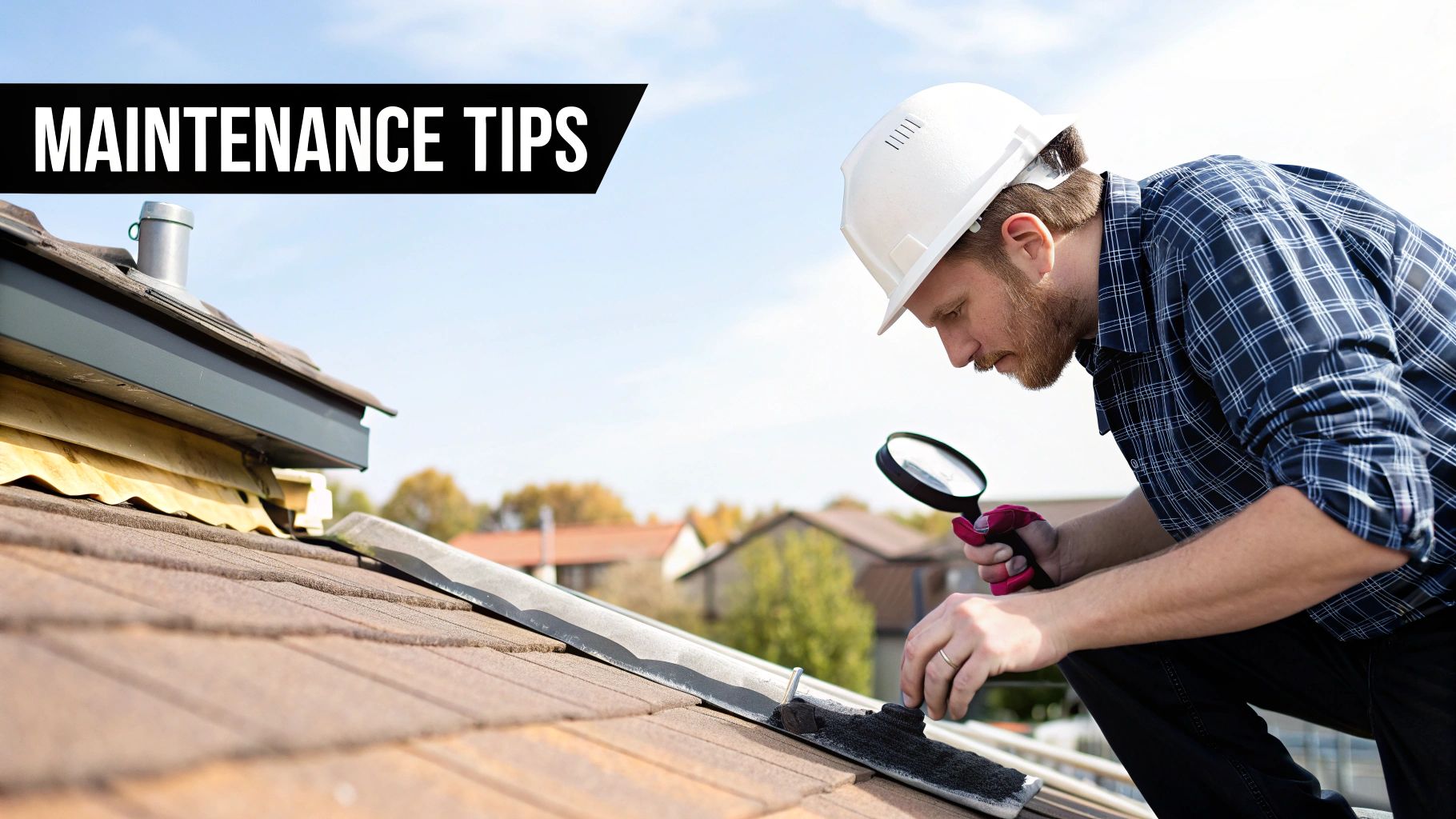
A new roof membrane is a great start, but the secret to getting its full 20 to 30-year lifespan is proactive care. Think of it like a car: you wouldn't drive it for years without an oil change and expect it to run perfectly.
Simple, consistent maintenance is the key to protecting your investment. It stops small, easy-to-fix issues from becoming major, expensive disasters. A few quick checks can keep you ahead of potential problems.
Your Seasonal Maintenance Checklist
A simple seasonal inspection is your most powerful tool. A quick walkaround, especially after a major South Florida storm, helps you spot and handle issues before they escalate.
Here is your actionable checklist:
- Look for Punctures or Tears: Scan the surface for small holes or rips from falling branches, hail, or careless foot traffic from other contractors.
- Clear All Drains and Scuppers: Ensure all drains, gutters, and scuppers are completely free of leaves and debris so water can drain quickly. This is the single most important maintenance task.
- Examine the Seams: Pay close attention to where the membrane sheets are joined. Look for any signs of peeling, cracking, or separation—these are the most common starting points for leaks.
The most common cause of premature roof failure isn't a faulty material. It's neglected maintenance. A single blocked drain can cause water to pool, putting immense stress on the seams and drastically shortening the life of your roof membrane.
How to Spot Early Warning Signs
Learn the visual cues that mean it's time to "call a professional." Catching these early can be the difference between a minor repair and a full replacement. After all, a solid roof is essential to the integrity of the whole structure, which you can see in how various South Florida homes are constructed.
Be on the lookout for:
- Blisters or Bubbles: These indicate trapped air or moisture and signal an adhesion failure that needs professional attention.
- Persistent Pooling Water: If you see puddles on your roof more than 48 hours after rain, it's a major red flag for a drainage problem.
- Visible Cracks or "Alligatoring": A pattern of cracks resembling alligator skin means the material is aging, becoming brittle, and losing its waterproofing ability.
When you spot any of these signs, it's time to call in a roofer. An expert eye ensures the problem is fixed right the first time, protecting your roofing system for the long term.
Understanding the Cost of a New Roof Membrane
When budgeting for a new roof membrane, several key factors determine the final price. Understanding them gives you a clear financial picture before you talk to contractors.
The biggest driver is the material you choose. A high-performance PVC membrane will have a higher upfront cost than a standard TPO or EPDM system. This choice is your first major impact on the budget.
Naturally, the size and complexity of your roof play a huge role. A simple, flat roof is easier and cheaper to cover than one with numerous vents, skylights, or multiple levels. Every penetration requires careful, time-consuming flashing, which adds to the labor cost. You can see what a clean, straightforward job looks like in this example of a properly completed roof membrane installation.
Key Variables That Affect Your Quote
Beyond the obvious, a few other things can move the needle on an estimate. A major wildcard is the condition of your existing roof deck. If the underlying wood is rotted or water-damaged, it must be replaced before the new membrane can be installed. This necessary step can add unexpected costs.
Local labor rates and global supply chain costs for raw materials also influence the final price.
The global market for waterproofing membranes, which includes all these roofing materials, is expected to grow to $47.71 billion by 2032. This huge demand means the market can be affected by fluctuating raw material prices, which can sometimes trickle down to what homeowners pay. You can get a deeper look at this growing market on Fortune Business Insights.
Thinking in Terms of Life-Cycle Cost
Here's a pro tip: Don't just focus on the initial quote. Smart homeowners think in terms of life-cycle cost—the total expense of owning the roof over its entire lifespan.
A cheaper membrane might save money today, but if it requires more repairs or needs replacement a decade sooner than a higher-quality system, it will cost you more in the long run. Spending more upfront for a durable material often provides a better return on investment through fewer repairs, lower maintenance, and a longer service life. This long-term perspective is the best way to make a solid financial decision for your home.
Have Questions About Roof Membranes? We’ve Got Answers.
When you're looking into a new roof, it's natural to have questions. Here are straightforward answers to the questions we hear most often from homeowners trying to decide if a roof membrane is the right call.
How Long Does a Roof Membrane Last?
This is a top question for a reason. You can generally expect a lifespan of 15 to 30 years, but the exact number depends on the material, quality of maintenance, and our intense South Florida climate.
- TPO and PVC: Typically provide 15-25 years of solid performance.
- EPDM: Is the longevity champion, often lasting 25-30 years or more.
These timelines depend entirely on a professional installation and consistent maintenance.
Can a Roof Membrane Be Installed Over an Existing Roof?
Sometimes, yes. This "roof-over" can save you money by avoiding a full tear-off.
Crucial Caveat: This is only an option if the existing structure is in excellent shape (no rot, no soft spots) and local building codes permit it. A professional inspection is non-negotiable. If any damage or multiple old layers are found, a complete tear-off is the only safe and responsible path forward.
Are Roof Membranes a Good Choice for Residential Homes?
Absolutely. They are often the best choice, especially for homes with flat or low-slope sections like modern additions, garages, or covered porches.
Traditional shingles are not designed for low pitches; they trap water and invite leaks. A membrane creates a seamless, watertight barrier that is far superior for these applications, offering better protection and potential energy savings.
If you have more questions about what a roof membrane can do for your South Florida home, the experts at Exact Roofing are here to help. Contact us today for a professional consultation and a clear path to a better, more durable roof.

